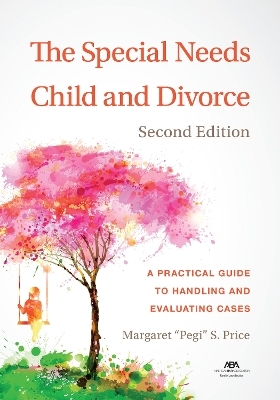
The Special Needs Child and Divorce
American Bar Association (Verlag)
978-1-63905-204-2 (ISBN)
- Titel z.Zt. nicht lieferbar
- Versandkostenfrei innerhalb Deutschlands
- Auch auf Rechnung
- Verfügbarkeit in der Filiale vor Ort prüfen
- Artikel merken
Special needs are often determined following the categories that the public education system considers eligible for special education services, including autism, physical limitation and health impairment, emotional disturbance, learning disability, and developmental delay, among many others. The author begins by discussing what special needs are in terms of legislation and how such cases are evaluated and then handled in the court. Issues addressed include the initial interview, drafting divorce petitions and motions, and legislation and case law.
The Special Needs Child and Divorce, Second Edition examines how child support guidelines and standard visitation schedules often don't meet the needs of special needs children, and Chapter 6 provides a model child support chart, parenting plan, and modification for these cases. Subsequent chapters address other aspects raised by handling a case with a special needs child, including maintenance and property division, the roles of the parties in the divorce process, guardianships, special needs trusts, and other estate planning issues.
Drawn from her years of experience in handling divorce and family court cases involving special needs children, the author provides numerous practice tips throughout the book. In addition, she includes valuable sample language and forms throughout the text that illustrate how modifications are needed to adequately address issues raised by a special needs child. Other chapters offer sample forms and documents that have been developed or adapted for use in divorce cases involving children with special needs and checklists to help guide you through the key elements of handling the case.
The author, Margaret “Pegi” S. Price, JD, is a professor and lawyer. Before going into full-time academia, her practice was limited exclusively to the practice of family law— divorce, paternity, child support, custody and visitation, guardianships, and adoptions. Pegi is a past chair of the Family Law Section of the Bar Association of Metropolitan St. Louis and was a member of AFCC, the Association of Family and Conciliation Courts, and of the National Council on Family Relations (NCFR). Pegi has written many legal articles on family law and other topics. She presented a paper and was a speaker at the 2006 World Autism Congress in Cape Town, South Africa, on the subject of divorce and families with autism. Pegi has also spoken on the subject of divorce and families with autism at the National Conference of the Autism Society of America and at regional legal community conferences and seminars for educators and professionals in the special needs community.
Contents
Author’s Note ix
About the Author xi
Acknowledgments xiii
Introduction xv
CHAPTER 1
What Are Special Needs? 1
I. Legislation Regarding Disabilities 2
II. Evaluating Special Needs in Family Court Cases 3
III. Case Management for the Courts 6
A. What Types of Special Needs Can a Child Have? 7
B. How Can the Lawyer or Judge Know When a Particular
Case Should Be Considered a Special Needs Case? 10
CHAPTER 2
How to Recognize and Handle Issues of Special Needs
in Family Law Cases 11
I. The Initial Client Interview 12
II. Drafting Divorce Petitions and Answers 17
III. Additional Litigation Stages 35
A. Interrogatories—Standard Question for Form Interrogatories 35
B. Discovery in General 36
C. Maintenance/Alimony Calculations 52
D. Parenting Plan 53
IV. Posttrial Motions 80
V. Undiagnosed Special Needs 84
A. Indicators That an Evaluation May Be Necessary 85
1. Autism 85
2. Hearing Deficits 86
3. Visual Deficits 86
4. Mental Retardation 87
5. Learning Disabilities 87
6. Attention-Deficit/Hyperactivity Disorder 89
7. Emotional Disturbances 90
8. Orthopedic Impairments 92
9. Multiple Disabilities 92
10. Traumatic Brain Injury 92
11. Other Health Impairments 93
VI. Recognizing and Applying Special Needs to Divorce Cases 93
CHAPTER 3
How Special Needs Can Affect a Child in a Divorce Case 95
I. Treating Children with Special Needs during Divorce 96
A. During the Divorce 97
B. After the Divorce 97
II. Impact of Divorce on Special Needs Children, by Category
of Special Need 98
A. Autism, Developmental Delays 98
B. Hearing Impairment, Visual Impairment, and Speech
or Language Impairment 98
C. Emotional Disturbance 99
D. Mental Retardation, Traumatic Brain Injury 99
E. Orthopedic Impairments, Other Health Impairments 99
CHAPTER 4
Why Child Support Guidelines and Standard Visitation Schedules
Do Not Meet the Needs of Special Needs Children 101
I. Child Support Charts 101
A. Short-Term Needs 101
1. Preexisting Expenses 101
2. Therapy 102
3. Equipment 103
4. Medication 103
5. Supplements 103
6. Dietary Costs 103
7. Sensory Items (Therapy, Different Clothing/Other Items,
Take-Along Items) 104
8. Respite Care 105
9. Professionals 106
10. Modifications to the Home Environment 106
11. Changes in the Child’s Needs 106
12. Costs Caused by the Divorce 107
B. Long-Term Needs 107
II. Visitation Schedules 108
A. Noncustodial Parent 108
1. Child’s Schedule 109
B. Environmental Modifications 111
CHAPTER 5
Legislation, Case Law, and Parenting Plans 113
I. Legislation 113
A. Federal Law 114
1. Health Care Issues 114
2. Educational Issues 115
B. State Law 116
II. Case Law 119
A. Standard Child Support Chart 123
B. Standard Parenting Plan 126
CHAPTER 6
Model Child Support Chart, Parenting Plan, and Modification 151
CHAPTER 7
Maintenance and Property Distribution in Special Needs Cases 165
I. Maintenance 165
II. Property Distribution 167
III. Retirement Accounts 167
IV. Career Advancement 168
CHAPTER 8
Roles of the Parties 169
I. Rights of the Parties 169
A. Special Needs Child 169
B. Custodial Parent (Primary Caregiver Parent) 169
C. Noncustodial Parent (Non–primary Caregiver Parent) 169
D. Lawyers 170
E. Judge 170
F. Guardian ad Litem/Special Needs Coordinator 171
G. Other Professionals 171
II. Responsibilities of the Parties 171
A. Special Needs Child 171
B. Parents 171
C. Lawyers 171
D. Judge 172
E. Other Professionals 172
III. Participation 173
CHAPTER 9
Special Considerations in Special Needs Family Law Cases 175
I. Individualized Education Plans (IEPs) and 504 Plans 175
II. Behavior—School and Criminal Justice System 177
III. Religion 178
IV. Parents with Special Needs 179
V. Planning for a Crisis 180
VI. Using Technology to Facilitate Co-Parenting 182
CHAPTER 10
Estate Planning for Families with Special Needs 183
I. Special Needs Trusts 184
II. Guardianships 185
III. Conservatorships 185
IV. Additional Estate Planning Options for Families with Special Needs 186
CHAPTER 11
Forms and Samples 187
CHAPTER 12
Resources 245
I. Center for Parent Information and Resources 245
II. State Councils on Developmental Disabilities 246
III. State Departments of Education 251
CHAPTER 13
Bibliography 257
CHAPTER 14
Checklists 275
1. Initial Interview—What to Ask the Client 275
2. Client File Contents—Items the Lawyer Should Have in Her Client
File When Handling a Special Needs Divorce Case 278
3. Drafting the Petition—Special Subject Areas for the Petition 279
4. Statement of Income and Expenses—What Should Be Included
in the Statement of Income and Expenses 279
5. Answer and Cross-Petition—How to Prepare the Answer
and Cross-Petition 279
6. Discovery—Subjects to Explore through the Discovery Process 280
7. Temporary Orders—Do You Need to File a PDL Motion
(Interim Order)? 284
8. Child Support—Special Considerations Regarding Child Support 285
9. Custody—Special Considerations Regarding Custody 285
10. Visitation—Special Considerations Regarding Visitation 286
11. Support Systems for the Special Needs Child—Help for the Special
Needs Child during and after Divorce 286
12. Property Distribution—Special Considerations Regarding Property
Distribution, Including Retirement Accounts 287
13. Counseling—Special Issues for Counseling 287
Parents 287
Special Needs Children 288
Siblings of Special Needs Children 288
Glossary 289
Index 297
| Erscheinungsdatum | 26.08.2023 |
|---|---|
| Zusatzinfo | Illustrations |
| Verlagsort | Chicago, IL |
| Sprache | englisch |
| Maße | 177 x 254 mm |
| Themenwelt | Recht / Steuern ► EU / Internationales Recht |
| Recht / Steuern ► Öffentliches Recht | |
| Recht / Steuern ► Privatrecht / Bürgerliches Recht ► Berufs-/Gebührenrecht | |
| Recht / Steuern ► Privatrecht / Bürgerliches Recht ► Familienrecht | |
| ISBN-10 | 1-63905-204-6 / 1639052046 |
| ISBN-13 | 978-1-63905-204-2 / 9781639052042 |
| Zustand | Neuware |
| Informationen gemäß Produktsicherheitsverordnung (GPSR) | |
| Haben Sie eine Frage zum Produkt? |
aus dem Bereich


